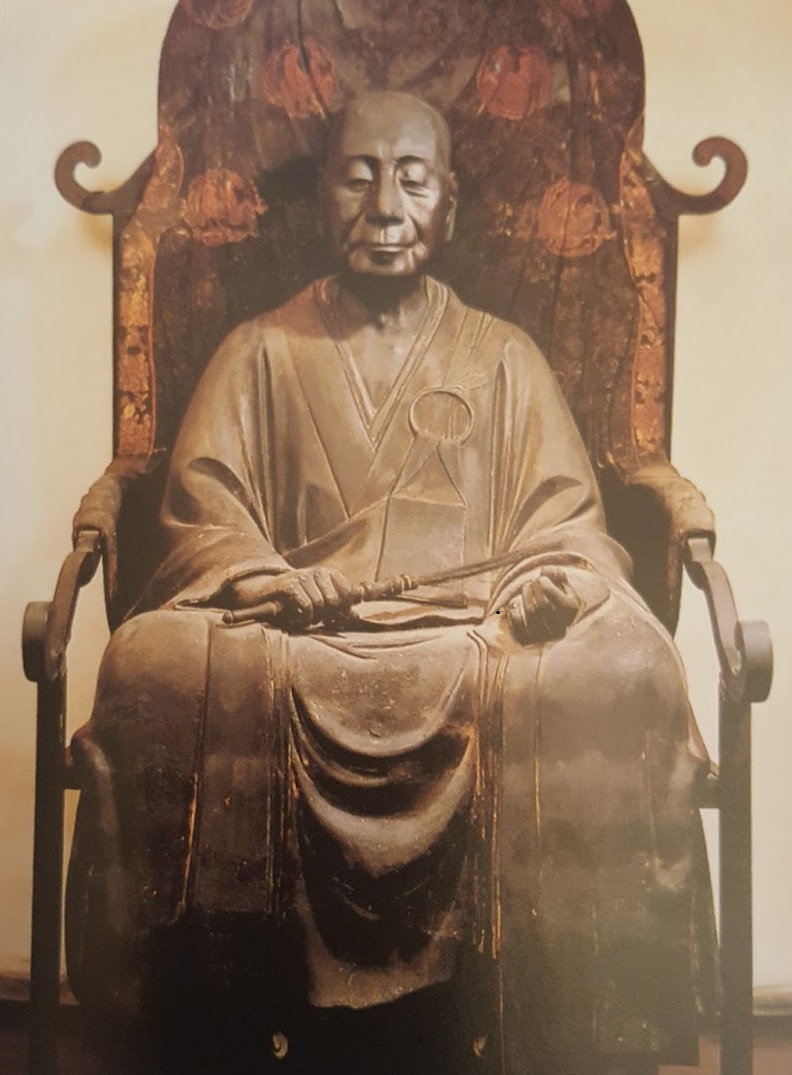ZEN IRODALOM ZEN LITERATURE
« Zen főoldal
« vissza a Terebess Online nyitólapjára

無住一円 Mujū Ichien* (1226–1312)
沙石集**
(Rōmaji:) 『沙石集』(しゃせきしゅう / させきしゅう) Shaseki shū
(English:) Sand and Pebbles / Collection of Stone and Sand
(Magyar:) Homok és kavics gyűjtemény
* 無住道曉 Mujū Dōkyō (1 January 1227 - 9 November 1312), birth name 一円道曉 Ichien Dōkyō
** The Shasekishū, also read as Sasekishū, translated into English as Sand and Pebbles, is a five-volume collection of Buddhist parables written by the Japanese monk Mujū in 1283 during the Kamakura period. It is popularly excerpted in English in 101 Zen Stories.
Tartalom |
Contents |
PDF: 101 zen történet [Kavics és homok] PDF: Százegy zen történet 5-97. oldal PDF: 101 zen történet 7-75. oldal |
PDF: Sand and pebbles (Shasekishū): the tales of Mujū Ichien, a voice for pluralism in Kamakura Buddhism PDF: "Mujū Ichien's Shinto-Buddhist Syncretism: Shasekishū, Tsuma kagami 妻鏡
"Mirror for Wives." PDF: Zen Sanctuary of Purple Robes
DOC: 101 Zen Stories
|
101 Zen Stories [Collection of Stone and Sand] DOC
101 Zen Stories PDF
Transcribed by Nyogen Senzaki (千崎如幻 1876–1958) & Paul Reps (1895-1990)
101 Zen Stones was first published in 1919 by Rider and Company, London, and David McKay Company, Philadelphia.
These stories recount actual experiences of Chinese and Japanese Zen teachers over a period of more than five centuries.101 Zen Stories / transcribed by Nyogen Senzaki and Paul Reps, Philadelphia, David McKay Company, 1940. 126 p.
is a 1919 compilation of Zen koans including 19th and early 20th century anecdotes compiled by Nyogen Senzaki, and a translation of Shaseki shū, written in the 13th century by Japanese Zen master Mujū (無住) (literally, "non-dweller"). The book was reprinted by Paul Reps as part of Zen Flesh, Zen Bones.
Shaseki-shū ( 砂石集 )
http://zenwort.lima-city.de/nihonryoiki/nr_htm/nr_einl_06.html#SHASEKI
Abkürzung: SS
Begonnen 1279, vollendet 1283; Mujū Ichien (無住一圓, 1226-1312), der die verschiedensten Lehrrichtungen durchwanderte und zuletzt sich ganz Zen zuwandte, spricht hier in 10 Bänden über das Mannigfaltigste des Buddhismus im Sinne des buddhistisch-religiösen Menschen der Kamakura-Zeit. Mujū lebte dann im Chomo-ji in der Provinz Ogami. Zu seinen weiteren Werken gehören Shozai shu (Sammlung von Schätzen der Weisheit) und Zodan shu (Gesammelte Reden).
"Tales from the Collection of Sand and Pebbles"
by Robert E. Morrell
Literature East and West, xiv:2 (1970), pp. 251-63.
PDF: Zen Sanctuary of Purple Robes
Japan's Tokeiji Convent Since 1285
by Sachiko Kaneko Morrell - Robert E. Morrell
Sunypress, 2006
Zen Sanctuary of Purple Robes examines the affairs of Rinzai Zen’s Tōkeiji Convent, founded in 1285 by nun Kakusan Shidō after the death of her husband, Hōjō Tokimune. It traces the convent’s history through seven centuries, including the early nuns’ Zen practice; Abbess Yōdō’s imperial lineage with nuns in purple robes; Hideyori’s seven-year-old daughter—later to become the convent’s twentieth abbess, Tenshu—spared by Tokugawa Ieyasu at the Battle for Osaka Castle; Tōkeiji as “divorce temple” during the mid-Edo period and a favorite topic of senryu satirical verse; the convent’s gradual decline as a functioning nunnery but its continued survival during the early Meiji persecution of Buddhism; and its current prosperity. The work includes translations, charts, illustrations, bibliographies, and indices. Beyond such historical details, the authors emphasize the convent’s “inclusivist” Rinzai Zen practice in tandem with the nearby Engakuji Temple. The rationale for this “inclusivism” is the continuing acceptance of the doctrine of “Skillful Means” (hōben) as expressed in the Lotus Sutra—a notion repudiated or radically reinterpreted by most of the Kamakura reformers. In support of this contention, the authors include a complete translation of the Mirror for Women by Kakusan’s contemporary, Mujū Ichien.
Table of Contents
Figures
Preface
Acknowledgments1. Winds of Doctrine: The World of Thought and Feeling in Late Kamakura Japan
2. Mujū Ichien’s Mirror for Women (Tsuma kagami, 1300): A Buddhist Vernacular Tract of the Late Kamakura Period
3. Abbess Kakusan and the Kamakura Hōjō
4. Princess Yōdō’s Purple-clad Nuns5. From Sanctuary to Divorce Temple: Abbess Tenshū and the Later Kitsuregawa Administrators
6. Everyday Life at Matèsugaoka Tōkeiji : Sacred and Secular
7. The “Divorce Temple” in Edo Satirical Verse
8. Meiji through Heisei: Tōkeiji and Rinzai Zen Continuity
Appendixes
Chart A.Zen Lineage from Śākyamuni to the Tōkeiji
Chart B.Kakusan’s Relationship to the Hōjō and Adachi Families
Chart C.From Ashikaga to the Kitsuregawa Administrators
Chart D.Relationships in the Tōkeiji Succession during the Late Muromachi and Early Edo Periods
Chart E.Tōkeiji Head Abbesses and Acting AbbessesNotes
Annotated Cross-Referenced Index to Major Cited Texts
Bibliography
Index
![]()
101 zen történet [Kavics és homok]
PDF: 101 zen történet; [ford. Bánfalvi András (1955-2002)]. Farkas Lőrinc Imre Könyvkiadó, [Budapest], 1994, 86 oldal
PDF: Százegy zen történet 5-97. oldal, in: A zen kapui : százegy zen történet: nincs kapu / [ford. Szigeti György]. Farkas Lőrinc Imre Könyvkiadó, [Budapest], 1998, 147, [6] oldal
PDF: 101 zen történet 7-75. oldal, in: Hús-vér zen / összeáll. Paul Reps; [ford. Acsai Roland]. Cephalion Kiadó, Szentendre, 2006, 136 oldal
[E mű négy könyvet foglal magában: A "101 Zen Történetet", mely több mint 500 év tapasztalatából merít, a "Kapu nélküli kaput", mely a megvilágosodást elősegítő, ősi koanok gyűjteménye, A "Tíz bikát", a szellemi előmenetel könyvét és végül a "Középpont felé" című ősi szanszkrit kézirat fordítását.]
69. Lenyelni a szégyent
Fordította: Terebess Gábor (Shaku Genshō)
A Kőrösi Csoma Sándor Intézet Közleményei, 1975. 3-4. szám, 68. oldalVáratlan vendégek érkeztek a kolostorba, és a szerzetes-szakács az összekapkodott zöldséggel, nyisz-nyisz, a nagy sietetségben egy kígyót is beleaprított a levesbe, anélkül, hogy észrevette volna.
Az ebéd közepe táján hívatták és Fúgai* mester egy hang nélkül elétartotta a kígyó fejét. A szakács kiragadta a mester ujjai közül a kígyófejet, egy „köszönömmel" lenyelte, és kisietett a teremből.* Fūgai Honkō (風外本高 1779-1847)
Tarnóczy Zoltán illusztrációja